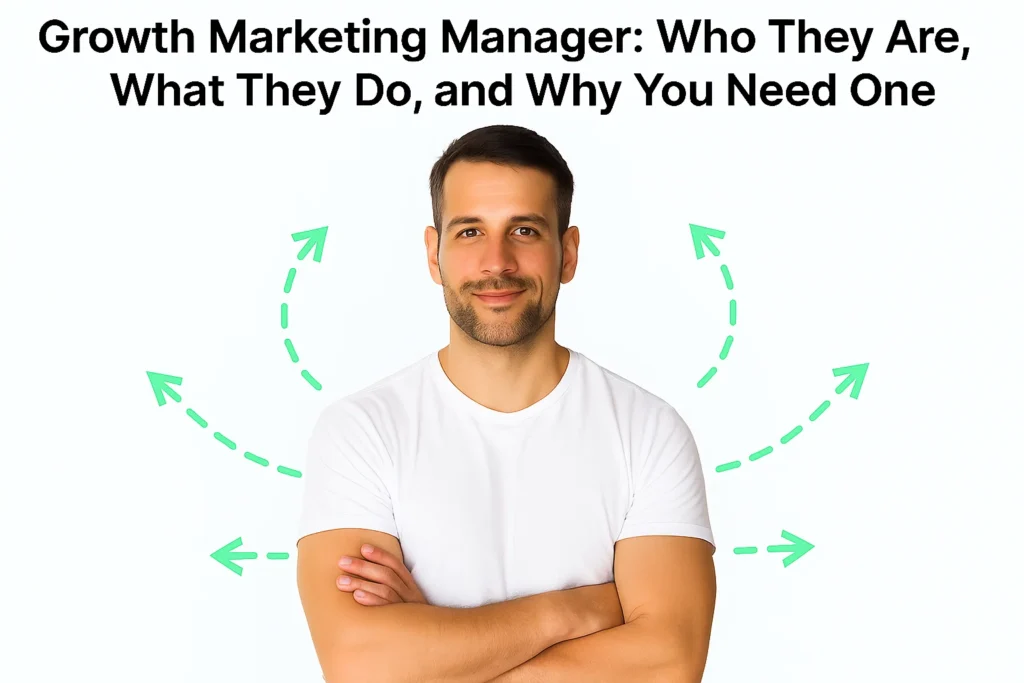What is a growth marketing manager?
Let’s be honest — titles like growth marketing manager get tossed around all the time on LinkedIn, in strategy meetings, and in SaaS funding announcements. But what do they actually do? And does your business really need one?
In simple terms, a growth marketing manager is the person responsible for unlocking sustainable, measurable growth across your customer journey. They’re not the ones focusing on fluffy branding or running disconnected ad campaigns. Their job is to drive real, revenue-focused outcomes — from bringing in qualified leads to converting them into loyal customers who stick around.
Think of them as the perfect mix of creativity, data obsession, and experimentation. They bridge the gap between marketing, sales, and product teams to help businesses grow smarter — not just bigger.
In today’s competitive SaaS, B2B, and product-led markets, having someone who owns growth across the entire customer lifecycle isn’t optional. It’s essential.
Why growth marketing matters for SaaS, B2B, and product-led companies
Scaling a product or service in today’s hyper-competitive market? It’s no small feat — especially for SaaS, B2B, or product-led businesses where growth needs to be both predictable and sustainable. That’s where growth marketing comes in.
Gone are the days when running a few ads and hoping for the best would cut it. If you want scalable, repeatable growth, you need someone driving strategy across the full customer journey — not just focusing on flashy top-of-funnel metrics.
A skilled growth marketing manager helps your business:
✔ Generate qualified leads that actually convert
✔ Reduce customer acquisition costs (CAC) over time
✔ Improve conversion rates across every stage of your funnel
✔ Increase retention and lifetime value (LTV)
✔ Align marketing, sales, and product teams toward one goal: revenue growth
Without this role, companies often hit common growth roadblocks — high churn, inconsistent lead quality, rising acquisition costs, or stalled pipeline velocity. Sound familiar? You’re not alone.
Growth marketing bridges the gap between tactics and outcomes — turning experiments into scalable, revenue-driving strategies.
What a growth marketing manager does day-to-day
Here’s the thing — no two days look the same for a growth marketing manager. That’s the nature of growth — it requires constant testing, tweaking, and collaboration. But there are common themes that define the role:
1. Experimentation and testing
They’re always testing — whether it’s A/B experiments on landing pages, tweaking email sequences, or trialing new acquisition channels. Growth isn’t a guessing game — it’s a science lab.
2. Cross-functional alignment
Growth happens when teams align. A great growth marketer works closely with product, sales, and revenue teams to ensure everyone is rowing in the same direction.
3. Data-driven decision making
Gut feeling has its place, but in this role, the numbers lead. Whether it’s optimizing paid campaigns, improving SEO performance, or enhancing retention strategies — it’s all about data-backed moves.
Think of them as part strategist, part data analyst, and part experiment junkie — always pushing for measurable, scalable growth.
Key skills of a successful growth marketing manager
Let’s be clear — not every marketer is built for growth. The best growth marketing managers bring a rare combination of technical expertise, creativity, and business acumen.
Here are the critical skills to look for:
✔ Data fluency — They’re comfortable living in dashboards, interpreting metrics like CAC, LTV, MQL-to-SQL conversion rates, and making decisions accordingly.
✔ Technical tool expertise — From CRM systems to marketing automation platforms and analytics tools — they navigate tech stacks with ease.
✔ Full-funnel mindset — They’re thinking beyond lead generation — focusing on activation, retention, upsells, and even referrals.
✔ Experimentation culture — Testing isn’t a side project — it’s the foundation of their daily work. They fail fast, learn faster, and keep iterating.
✔ Customer obsession — They don’t just look at numbers — they understand the people behind them. From pain points to motivations, customer insight shapes their strategy.
Bonus points? They communicate complex ideas simply, collaborate cross-functionally, and stay curious — essential traits in high-growth environments.
Traditional marketing vs. growth marketing — key differences
Here’s a conversation I’ve had with more founders and marketing leaders than I can count:
“We’ve invested in marketing… so why aren’t we seeing predictable growth?”
The short answer? Traditional marketing and growth marketing play very different roles. When you rely on one without the other, gaps appear.
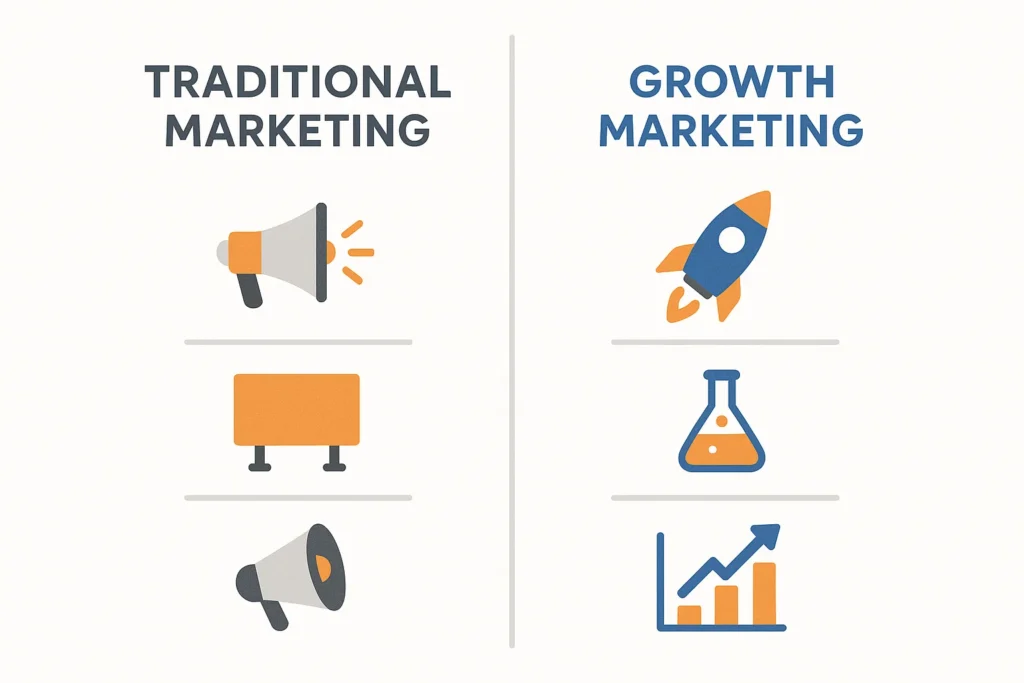
Traditional marketing focuses on:
- Building brand awareness
- Driving impressions and reach
- Large, campaign-driven tactics
- Longer timelines, slower iteration
It’s essential for creating recognition and credibility — but by itself, it often lacks the precision or speed needed for measurable growth.
Growth marketing, by contrast, is:
- Deeply data-driven and experiment-focused
- Geared toward revenue outcomes (think conversions, pipeline, LTV)
- Full-funnel — touching acquisition, retention, and expansion
- Iterative and agile — built on constant testing and optimization
Here’s the secret most high-growth companies understand: It’s not either/or. Smart teams blend both approaches. Brand lays the foundation; growth marketing accelerates results.
If your business feels stuck — brand visibility but stagnant pipeline — it’s likely time to dial up your growth marketing capabilities.
Strengths and weaknesses of growth marketers
A great growth marketing manager can be a game-changer — but no one is perfect. Understanding both their strengths and potential blind spots helps you hire smart and build a balanced team.
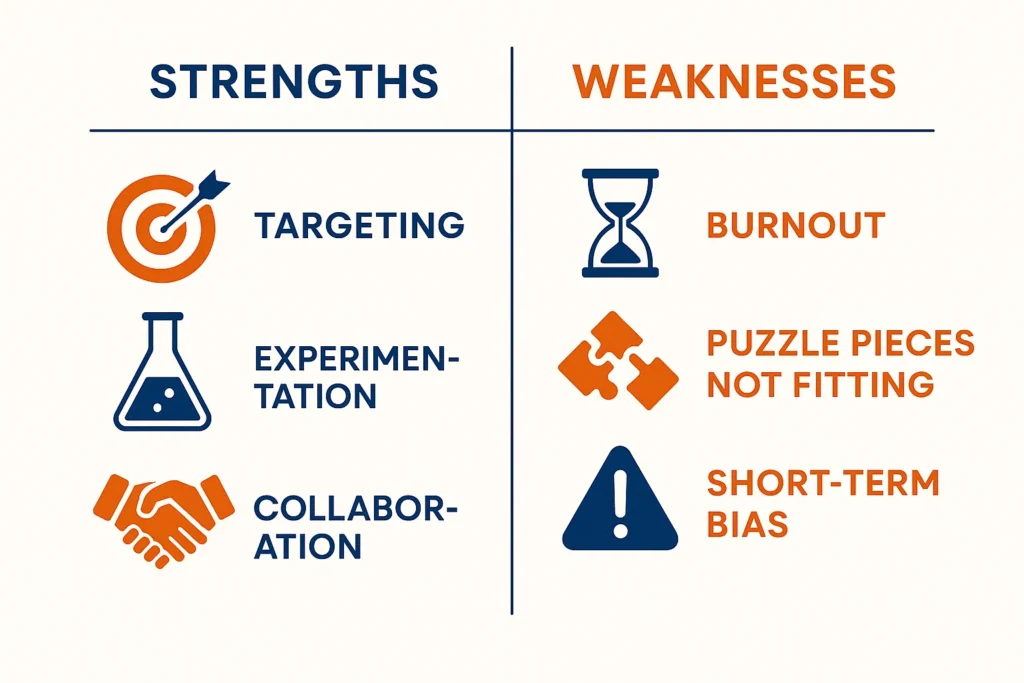
Strengths you can expect:
✔ Laser-focused on outcomes and revenue impact
✔ Comfortable with ambiguity, rapid iteration, and experimentation
✔ Technically fluent — they thrive in marketing tech stacks
✔ Quick learners who adapt to changing market dynamics
✔ Skilled at aligning marketing, product, and sales teams
Potential weaknesses to watch for:
⚠️ They may deprioritize long-term brand building in pursuit of quick wins
⚠️ Without clear leadership, they risk running disconnected tests without strategic alignment
⚠️ Some can undervalue the creative, emotional side of marketing that drives connection
⚠️ High workloads can lead to burnout, especially if they own too much of the funnel alone
The solution? Balance. Pair your growth marketer with strong brand, product, and creative resources to maximize their impact without sacrificing sustainability.
When to hire a growth marketing manager
Not every business needs a growth marketer on day one — but scaling without one eventually hits a ceiling.
Here are clear signs your company is ready for this role:
✅ You’ve achieved product-market fit, but growth has stalled
✅ Your customer acquisition costs (CAC) are rising faster than revenue
✅ You rely too heavily on one or two channels for leads
✅ Marketing, sales, and product teams feel disconnected or misaligned
✅ Your growth experiments are inconsistent or based on guesswork
In SaaS, B2B, or product-led environments, this often happens post-Series A — when early momentum fades, and scalable, predictable growth becomes mission-critical.
If growth feels accidental, disjointed, or unpredictable — it’s probably time to bring in a dedicated growth marketing manager.
The growth marketing strategy framework (practical steps)
Every great growth marketing manager follows a system — one that’s structured enough to drive results, but flexible enough to evolve with your business. Without a clear framework, growth becomes guesswork.
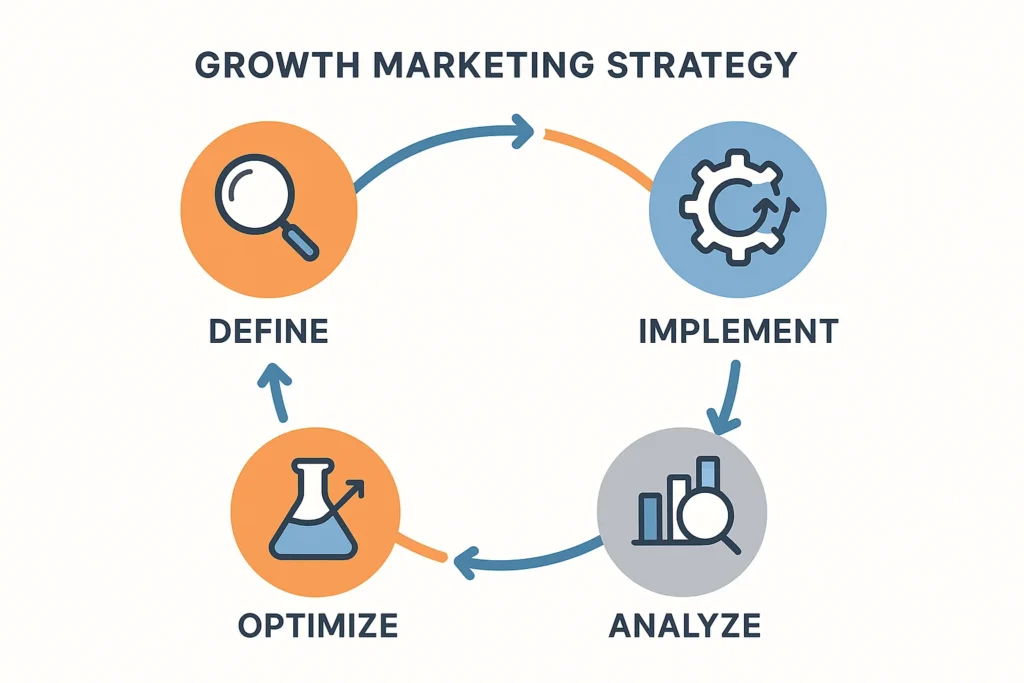
Here’s the battle-tested process used by successful growth marketers in SaaS, B2B, and product-led companies:
1. Diagnose your current state
Before jumping into tactics, they map the customer journey, analyze funnel performance, and identify the biggest blockers to growth.
2. Form data-backed hypotheses
They ask targeted questions like:
“If we improve onboarding emails, will activation rates rise?”
“Can we lower CAC by optimizing our paid campaigns?”
Every good test starts with a measurable, testable hypothesis.
3. Rapid experimentation
Time for action. Whether it’s A/B testing landing pages, trialing new channels, or optimizing nurture flows — experiments happen fast, with data guiding every step.
4. Scale proven wins
Once something works, they double down — automating successful tactics, reallocating budget to high-performing channels, and building scalable processes.
5. Continuous review
Growth is never a “set it and forget it” exercise. They run retrospectives, document learnings, and refine strategies based on fresh data.
Growth marketing is a flywheel, not a one-time project — and this framework keeps it spinning efficiently.
How to hire the right growth marketing manager
Deciding to hire is one thing — finding the right person? That’s where many companies stumble. Plenty of marketers claim “growth” on their resume, but not all can deliver measurable results.
Smart interview questions to ask:
✔ “Walk me through a growth experiment you designed. What was your hypothesis? What did you learn?”
✔ “How have you collaborated with sales, product, or revenue teams?”
✔ “What metrics do you care about most when evaluating success?”
✔ “Tell me about a failed experiment and what you changed afterward.”
Look for structured, data-backed answers — and a mindset focused on learning, not ego.
Red flags to avoid:
🚩 Overemphasis on vanity metrics like impressions or clicks
🚩 Little to no full-funnel experience (only top-of-funnel expertise)
🚩 Avoids discussing failed experiments (growth requires trial and error)
🚩 Struggles to articulate how their work impacts revenue
The right hire is transparent, curious, data-obsessed, and collaborative. If they lack those traits? Keep looking.
Setting your growth marketing manager up for success
Even the most talented growth marketer will struggle without the right support. Here’s how to set them up to deliver:
Tools, data, and clear KPIs
Provide access to reliable CRM systems, marketing automation platforms, analytics dashboards, and customer insights. Align on clear metrics — pipeline growth, CAC, LTV, conversion rates — not just “activity.”
Cross-team collaboration
Growth touches every department. Encourage regular collaboration between marketing, sales, product, and revenue teams to eliminate silos.
Executive buy-in
Without leadership alignment, growth initiatives stall. Make sure executives understand the role’s value — and give your growth marketer room to experiment, fail, and iterate.
Growth marketing is a team sport. Success requires alignment, resources, and shared accountability.
How to measure growth marketing success
Growth isn’t just about doing more — it’s about driving better, measurable outcomes. Here’s how to track whether your growth marketing manager is delivering:
✔ Increased qualified pipeline and lead quality
✔ Improvements in customer acquisition cost (CAC) and overall marketing efficiency
✔ Higher conversion rates at key funnel stages
✔ Enhanced lifetime value (LTV) and retention
✔ Faster experimentation cycles with clear, documented learnings
If these metrics are trending in the right direction, your growth marketing investment is paying off.
Is this the right hire for your company?
Bringing in a growth marketing manager isn’t always the first step — but for companies with product-market fit and stalled momentum, it’s often the missing piece.
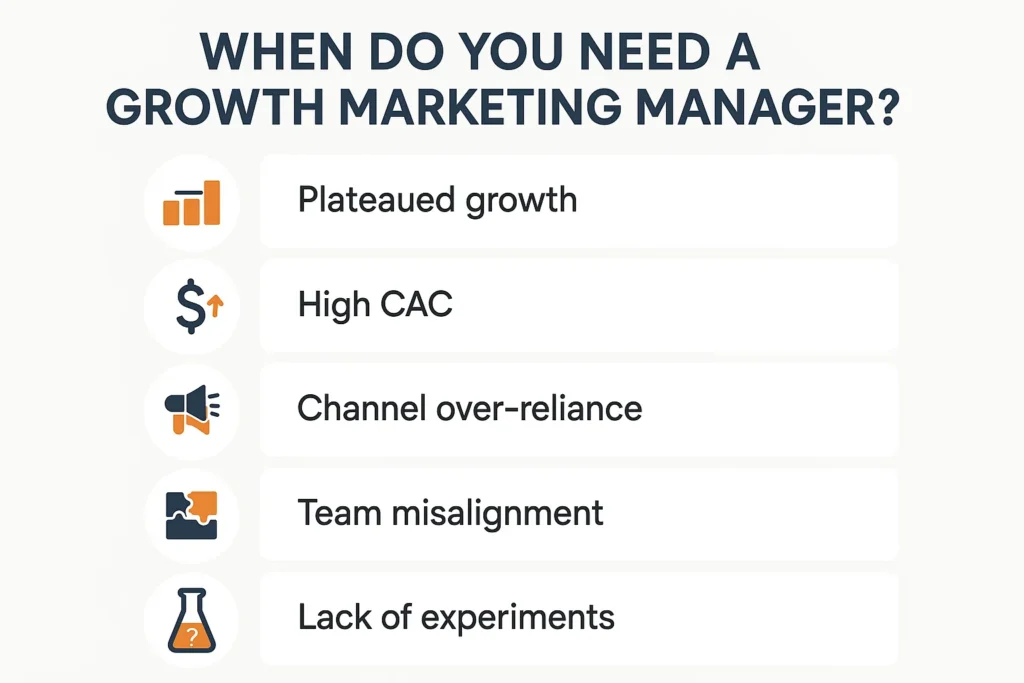
You’re ready if:
- Growth has plateaued or become unpredictable
- Your CAC is rising without efficiency improvements
- Teams feel disconnected, and experiments lack structure
- You’re struggling to scale revenue sustainably
A skilled growth marketing leader won’t magically fix everything overnight — but they will align teams, drive measurable outcomes, and unlock scalable, sustainable growth.
Curious if now’s the right time to hire? I help SaaS, B2B, and product-led companies build data-driven, scalable growth strategies — let’s connect for a no-pressure conversation.

